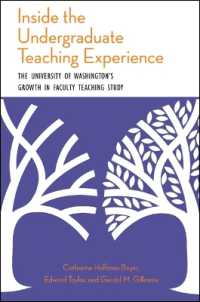- ホーム
- > 洋書
- > 英文書
- > Religion / Ethics
Full Description
Illness and Immortality examines a medieval Sanskrit text, the Netra Tantra, which is devoted to health and healing through a yogic practice dedicated to the chanting of mantras, the building of mandalas, and meditation. Patricia Sauthoff examines the role of such ritual elements in rites to alleviate illness and death. She includes analysis of the various forms of the deity Amrtesa or Mrtyuñjaya (Conqueror of Death), the nature of mantra, and the relationship between the tantric practitioner and the patient. This work explores what is meant by immortality within the medieval context and how one goes about attaining it. It asks how ritual alleviates illness, what role the deity plays in health and healing, and finally who has access to the rites described within the text. Central to this study is the conception of a body vulnerable to demons and reliant on deities for continued existence, and how the three yogic bodies (sthula, suksma, and para) play a role in physical and spiritual well-being. Featuring new translations of large sections of the Netra Tantra, the book offers readers various points of entry into the text so that tantric practitioners and scholars alike can access the influential and important concepts and practices found within this long-revered but under-studied work.
Contents
Preface
Introduction
A. Summary
B. Importance of Study
Chapter One: Mantra
I. Om Jum Sah: decoding the mantra
A. Overview of Tantric mantras
B. Encoding the mantra: NT 2.17-33
II. Language, the Body, and Mantra
A. The Nature of Mantra
B. Mantric Physicality: Siva, anu, and consciousness, NT 21.1-19
C. The Mrtyuñjaya Mantra: Exposition on the components of om jum sah NT 22.5-18
Chapter Two: Iconography
I. Iconography: the various forms of Ametesa
A. Visual representations in art history
B. The mythology of Siva
II. Mrtyujit in literature
A. Worshipping Amrtesa
B. Deities in the Netra Tantra
Chapter Three: Mandalas
I. Mandala: locating the divine in the physical world
II. Conclusion
Chapter Four: Diksa
I. Creating the Tantric Identity
II. Caste: initiation and purity
III. Purity and Interpretation: auspicious and inauspicious in the Svacchanda Tantra
Chapter Five: Nirajana
I. Diksa: building a new identity through initiation
A. Transgression: the benefits of breaking the rules
II. Religion of Monarchs
A. Kings, Poets and Patronage
B. Protecting the King: Netra Tantra 19.84-133
C. Private nirajana: Netra Tantra 15.1-19a
III. Conclusion
Chapter Six: Yoga
I. Conquering Death Through Ritual
A. Impurities, Kapalikas, and Exorcism
B. Vanquishing Death: mrtyu vañcana
II. Sthula Yoga
A. Maintaining the Physical Body
B. Easing the Pain of Death and Disease
C. Mandalas of Protection
D. Mantra and Color
III. Visualizing Amrta: Svacchanda Tantra 7.207-225
IV. Conclusion
Conclusion








